Contents
Market Overview
Macro Review
U.S. debt ceiling risks continue to rise. The U.S. 5-year credit default swap continued to widen over the week, just as 3-month T-Bills rose to yields not seen since 2007. The comparison to 2011 is becoming stronger: we note that EM assets performed well then (especially EM rates), while developed market equities corrected sharply lower. This culminated in an S&P downgrade in August 2011, with the U.S. losing its AAA rating. As such, 2011 has become a case study for where markets may head in the coming months. Currently, the added complication is softening U.S. growth with 1Q GDP of just 1.1%, which was flat to the Atlanta Fed’s GDPNow a day earlier. That is coupled with a degree of stickiness to inflation as Core PCE and UMich inflation expectations showed just that. The consternation over U.S. regional banks remained and we can expect further headlines over the weekend regarding First Republic’s rescue plan. Other key events that stood out were Argentina’s BCRA that hiked rates by 1,000bps, Ecuador announced an $800m buyback and Bolivia nationalized one of its leading banks. Colombia’s cabinet also resigned at the request of President Petro, with Finance Minister Ocampo no longer featured on the team-sheet, sending Colombian assets into a brief tailspin. Meanwhile, Pakistan published its first debt sustainability report ahead of an expected IMF deal next week. The final electoral polls in Turkey are also due soon, as Erdogan’s campaign strengthened considerably over the recent weeks, despite concerns around his health. Finally, Hungary is set to be become one of the first EM central banks to cut policy rates after lowering the top-rate of the interest rate corridor, but a base rate cut isn’t expected until the top-rate (20.5%) converges with the policy rate (13.0%).
EM Credit Update
Emerging market sovereign credit (cash bonds) ended the week up 0.4% with spreads 1bp tighter. Sovereign outperformers were Ghana, Zambia and Ecuador, while Sri Lanka, Pakistan and Tunisia underperformed. There are several consistent trends emerging. Firstly, broader market volatility has receded (via the VIX and U.S. Treasury’s MOVE Index), but macroeconomic uncertainty dented risk appetite. The dent in risk appetite led to IG/HY decompression and kept HY under pressure, while IG rallied as U.S. Treasuries yields fell (5-12bps). A weaker USD has lifted EM local markets as we approach the end of the tightening cycle in EM and DM, and key countries like Hungary have begun to benefit substantially from this.
The Week Ahead
FOMC, ECB and RBA rate decisions stand out next week. The former two are expected to hike rates by 25bps, while the RBA is expected to hold rates unchanged having paused the tightening cycle in early April. Euro-area CPI is also due and ought to show further easing. The trend in Europe on Friday was of accelerating inflation in France and Spain, while Euro-area GDP ticked up 0.1% (consensus -0.2%) as France and Italy avoid technical recessions. Meanwhile, Germany was an exception as inflation fell to 7.2% from 7.4% as food prices continue to decline. A similar theme is evident in Turkey, with CPI expected to decline to 44% from 50% on account of food price base effects. EM rate decisions include Brazil (13.75%) and Malaysia (2.75%). The overwhelming focus will rest with the Fed’s FOMC as recent rhetoric, PCE and claims have convinced the market that a hike is coming, yet consensus around the upcoming NFP showing the slowest pace of net adds since 2020. Finally, China PMI is due and is likely to edge down after the strength seen in early April.
Highlights from emerging markets discussed below:
Finance Minister Ocampo’s departure from the Petro Administration is credit-negative for Colombia, but its strong institutional framework is likely to remain a check on radical policy changes and Hungary rate cut largely symbolic, reflecting authorities’ confidence in the forint (HUF).
Fixed Income
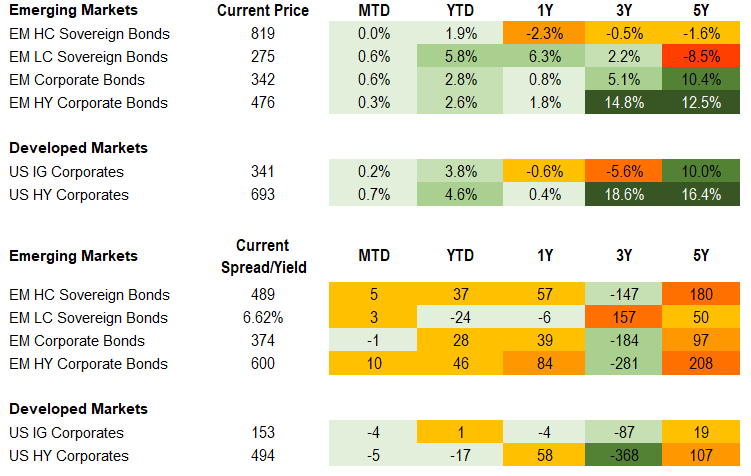
Equities
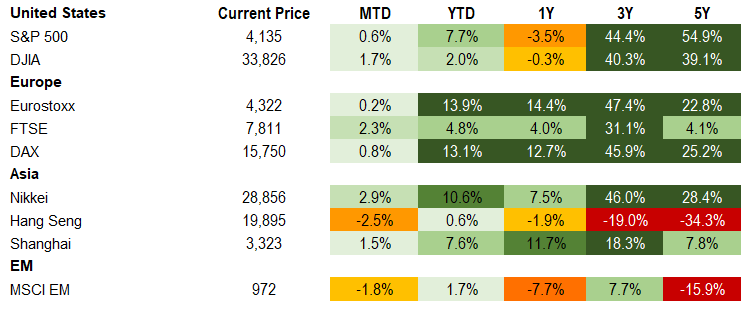
Commodities

Source for data tables: Bloomberg, JPMorgan, Gramercy. EM Fixed Income is represented by the following JPMorgan Indicies: EMBI Global, GBI-EM Global Diversified, CEMBI Broad Diversified and CEMBI Broad High Yield. DM Fixed Income is represented by the JPMorgan JULI Total Return Index and Domestic High Yield Index. Fixed Income, Equity and Commodity data is as of April 28, 2023 (mid-afternoon).
Emerging Markets Weekly Highlights
Finance Minister Ocampo’s departure from the Petro Administration is credit-negative for Colombia, but its strong institutional framework is likely to remain a check on radical policy changes
Event: Frustrated by the lack of support for his ambitious reform plans, even within his own political coalition, Colombia’s left-wing President, Gustavo Petro announced the end of his largely transactional coalition and reshuffled his cabinet, replacing several ministers, including Finance Minister, Jose Antonio Ocampo.
Gramercy commentary: For markets, Mr. Ocampo’s replacement, Ricardo Bonilla, a long-time aide to Petro, is the most important development amid this episode of political turmoil. Mr. Ocampo was seen as a key market-friendly voice within the otherwise populist leaning Petro Administration and a guarantor of fiscal policy credibility. As such, his departure is likely to have a negative impact on business confidence domestically and has weighed down on Colombian assets this week. This being said, Petro’s coalition collapse and the President’s failure to push his reform agenda through a centrist Congress, parts of which have been seen as a deviation from Colombia’s free market economic model, also show that checks and balances within the system have been able to limit the more radical policy initiatives. Ricardo Bonilla, Mr. Ocampo’s replacement, has vouched continuity with his predecessor’s work but markets are likely to doubt Mr. Bonilla’s ability and/or willingness to offer a similar counterbalancing weight on fiscal policy against Mr. Petro’s more populist tendencies. In our view, Petro’s main reform agenda items – pension, labor and healthcare, remain unlikely to pass unless significantly watered down by Congress.
Hungary rate cut largely symbolic, reflecting authorities’ confidence in the forint (HUF)
Event: The National Bank of Hungary cut the upper bound of its overnight interest rate corridor by 450bps to 20.5% leaving the door open for a cut in the one-day deposit rate at future meetings. The HUF was relatively well-contained, particularly in the context of recent robust current account data.
Gramercy commentary: We see the measure as an initial step in the potential easing process with limited implications on monetary conditions given transactions were generally not going through at this level. The start of the significant improvement expected in the current account and a soft dollar has helped anchor HUF in the aftermath. That said, still elevated inflation at 25% and sticky core and services prices leave the timing of more impactful easing uncertain. The performance of the forint in the context of future rate cuts will depend on external conditions and the scope of inflation reduction, additional current account improvement and developments related to the unlocking of pending EU funds.
Emerging Markets Technicals
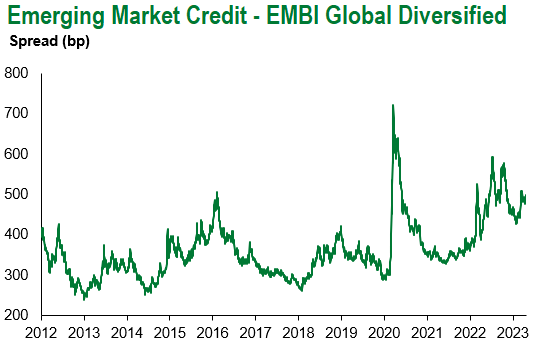
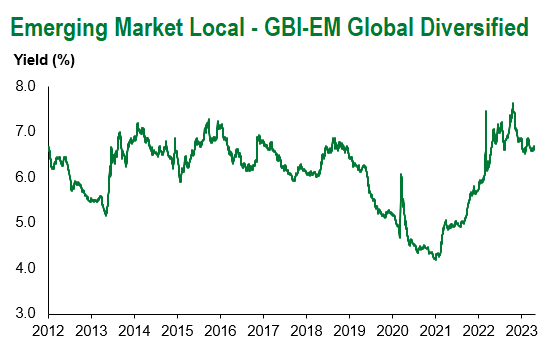
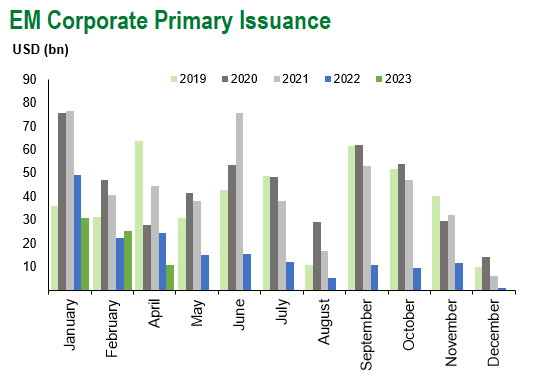
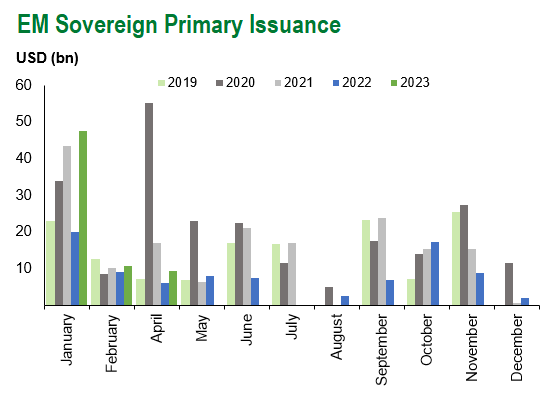
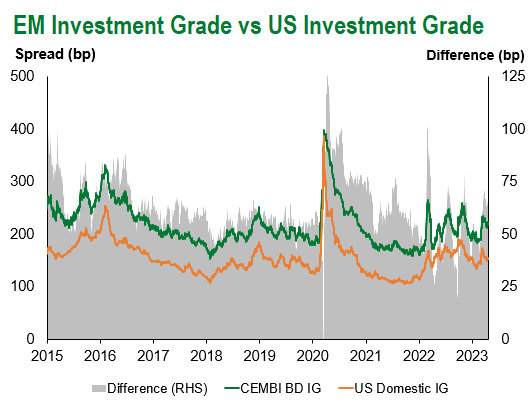
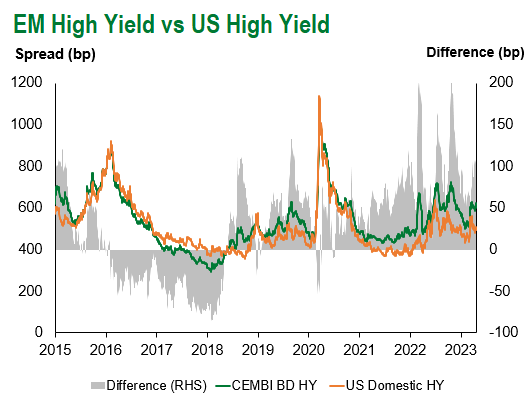
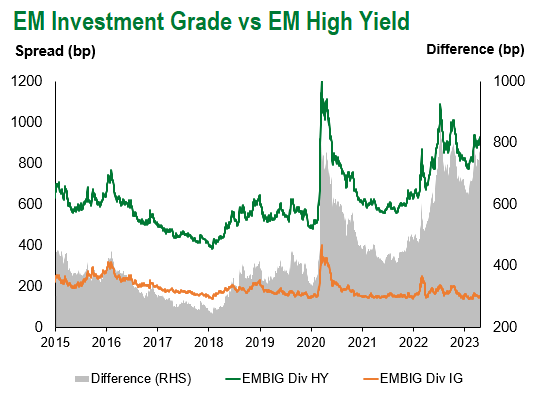
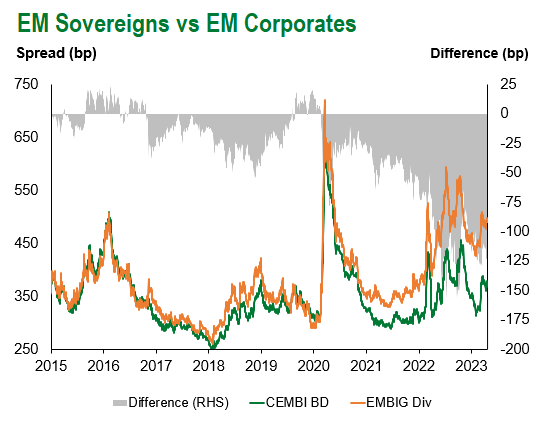
Emerging Markets Flows
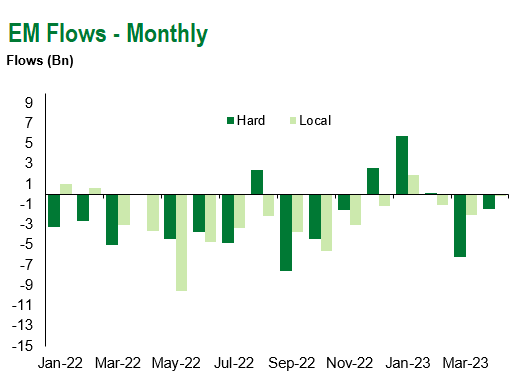
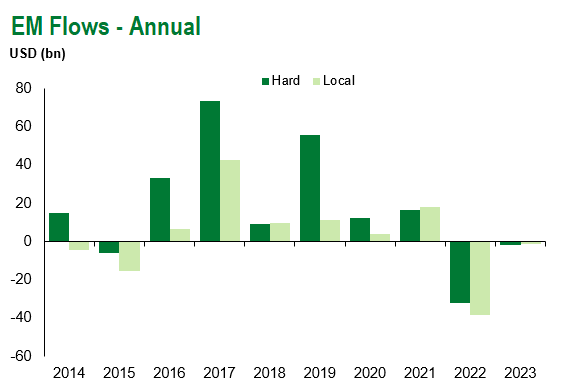
Source for graphs: Bloomberg, JPMorgan, Gramercy. As of April 28, 2023.
For questions, please contact:
Kathryn Exum, CFA ESG, Director, Co-Head of Sovereign Research, [email protected]
Petar Atanasov, Director, Co-Head of Sovereign Research, [email protected]
James Barry, Director, Deputy Portfolio Manager, [email protected]
This document is for informational purposes only. The information presented is not intended to be relied upon as a forecast, research or investment advice, and is not a recommendation, offer or solicitation to buy or sell any securities or to adopt any investment strategy. Gramercy may have current investment positions in the securities or sovereigns mentioned above. The information and opinions contained in this paper are as of the date of initial publication, derived from proprietary and nonproprietary sources deemed by Gramercy to be reliable, are not necessarily all-inclusive and are not guaranteed as to accuracy. This paper may contain “forward-looking” information that is not purely historical in nature. Such information may include, among other things, projections and forecasts. There is no guarantee that any forecasts made will come to pass. Reliance upon information in this paper is at the sole discretion of the reader. You should not rely on this presentation as the basis upon which to make an investment decision. Investment involves risk. There can be no assurance that investment objectives will be achieved. Investors must be prepared to bear the risk of a total loss of their investment. These risks are often heightened for investments in emerging/developing markets or smaller capital markets. International investing involves risks, including risks related to foreign currency, limited liquidity, less government regulation, and the possibility of substantial volatility due to adverse political, economic or other developments. References to any indices are for informational and general comparative purposes only. The performance data of various indices mentioned in this update are updated and released on a periodic basis before finalization. The performance data of various indices presented herein was current as of the date of the presentation. Please refer to data returns of the separate indices if you desire additional or updated information. Indices are unmanaged, and their performance results do not reflect the impact of fees, expenses, or taxes that may be incurred through an investment with Gramercy. Returns for indices assume dividend reinvestment. An investment cannot be made directly in an index. Accordingly, comparing results shown to those of such indices may be of limited use. The information provided herein is neither tax nor legal advice. Investors should speak to their tax professional for specific information regarding their tax situation.
